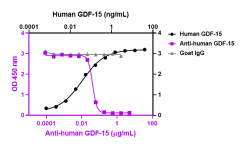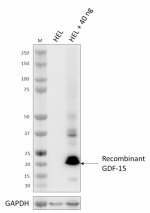- Clone
- Poly5243 (See other available formats)
- Regulatory Status
- RUO
- Other Names
- MIC-1, NAG-1, pTGFB, PDF, PLAB
- Isotype
- Goat Polyclonal IgG
- Ave. Rating
- Submit a Review
- Product Citations
- publications

-

Recombinant human GDF-15 (black circles) binds to immobilized recombinant GDNF receptor-alpha-like. LEAF™ Purified anti-human GDF-15 (Poly5243) (purple squares) inhibits the binding in a dose-dependent manner, whereas the LEAF™ purified goat IgG isotype control (gray triangles) does not have the effect. This antibody blocks the binding of 1 ng/mL human GDF-15 to 0.1 µg/mL immobilized recombinant GDNF receptor-alpha-like. ND50 range is 0.016 – 0.1 µg/mL. -

Whole cell extracts (15 µg total protein) from HEL cells spiked with the indicated amount of recombinant human GDF-15 protein were resolved by 4-12% Bis-Tris gel electrophoresis, transferred to a PVDF membrane, and probed with 0.125 µg/mL LEAF™ purified anti-human GDF-15 (clone Poly5243) for overnight at 4°C. Proteins were visualized by chemiluminescence detection using HRP donkey anti-goat. Direct-Blot™ HRP anti-GAPDH (Cat. No. 607904) was used as a loading control at a 1:50000 dilution. Lane M: Molecular weight marker.
| Cat # | Size | Price | Quantity Check Availability | Save | ||
|---|---|---|---|---|---|---|
| 524303 | 100 µg | 368€ | ||||
GDF-15 is a member of the TGF-β superfamily. GDF-15 is expressed as a 308 amino acids precursor that includes a signal peptide, a pro-domain, and a 112 residues mature protein. The secreted pro-domain binds to the extracellular matrix, where it can be activated by multiple enzymes such as furin (PCSK3), PCSK5, PCSK6, MMP-26, and MT1-MMP. GDF-15 is mainly expressed in placenta and prostate. Its expression is low in other tissues such as kidney, bladder, stomach, pancreas, liver, and gall bladder. GDF-15 is highly expressed in cancer cells with high levels detected in serum of cancer patients. GDF-15 has an important role in metabolic syndrome. GDF-15 transgenic mice present a lean phenotype. Furthermore, GDF-15 affects the macrophages in adipose tissue. Lean adipose tissue is characterized by the presence of anti-inflammatory M2-like macrophages. In obese individuals, adipose tissue show presence of CD8 effector cells and recruitment of inflammatory M1 macrophages. The increase of M1 macrophages over M2 results in metabolic changes, increase of TNFα, induction of glucose intolerance, and insulin insensitivity. GDF-15 binds to the GDNF receptor family member alpha like (GFRAL) which interacts with the co-receptor RET.
Product DetailsProduct Details
- Verified Reactivity
- Human
- Antibody Type
- Polyclonal
- Host Species
- Goat
- Immunogen
- Recombinant Human GDF-15
- Formulation
- 0.2 µm filtered in phosphate-buffered solution, pH 7.2, containing no preservative.
- Endotoxin Level
- Less than 0.1 EU/µg of the protein (< 0.01 ng/µg of the protein) as determined by the LAL test.
- Preparation
- The LEAF™ (Low Endotoxin, Azide-Free) antibody was purified by affinity chromatography.
- Concentration
- Lot-specific (to obtain lot-specific concentration and expiration, please enter the lot number in our Certificate of Analysis online tool.)
- Storage & Handling
- Upon receipt, store frozen at -20°C. Make small volume aliquots if needed and avoid repeated freeze-thaw cycles to prevent denaturing the antibody.
- Application
-
Blocking - Quality tested
WB - Verified - Recommended Usage
-
Each lot of this antibody is quality control tested by blocking the binding of 1 ng/mL human GDF-15 to 0.1 µg/mL immobilized recombinant GDNF receptor-alpha-like. ND50 = 0.016 – 0.1 µg/mL. For western blotting, the suggested use of this reagent is 0.125 - 1.0 µg/mL. It is recommended that the reagent be titrated for optimal performance for each application.
- RRID
-
AB_3068224 (BioLegend Cat. No. 524303)
Antigen Details
- Structure
- Homodimer
- Distribution
-
Macrophages, adipocytes, cardiomyocytes, endothelial, and vascular smooth muscle cells. Expressed mainly in placenta and prostate.
- Function
- Regulates metabolism, appetite, cell survival, and immune tolerance. Regulated by androgens and calcitriol in prostate. Induced by inflammatory cytokines: IL-1b, TNFa, IL-2, and G-CSF.
- Interaction
- Neurons, gastric cancer cells, normal gastric mucosal cells, adipose tissue
- Ligand/Receptor
- GFRAL
- Cell Type
- Endothelial cells, Macrophages, Neurons
- Biology Area
- Cancer Biomarkers, Immuno-Oncology
- Molecular Family
- Growth Factors
- Antigen References
-
- Bootcov MR, et al. 1997. Proc Natl Acad Sci USA. 94:1151.
- Emmerson PJ, et al. 2017. Nat Med. 23:1215.
- Li J, et al. 2018. Mol Cell Biol. 38: e00249.
- Li S, et al. 2014. J Clin Endocrinol Metab. 99: E2277.
- Nishimura S, et al. 2009. Nat Med. 15:914.
- Lackey DE, et al. 2016. Nat Rev Endocrinol. 12:15.
- Buchholz K, et al. 2021. J Cancer. 12:4698.
- Gene ID
- 9518 View all products for this Gene ID
- UniProt
- View information about GDF-15 on UniProt.org
Related Pages & Pathways
Pages
Related FAQs
- Do you guarantee that your antibodies are totally pathogen free?
-
BioLegend does not test for pathogens in-house aside from the GoInVivo™ product line. However, upon request, this can be tested on a custom basis with an outside, independent laboratory.
- Does BioLegend test each Ultra-LEAF™ antibody by functional assay?
-
No, BioLegend does not test Ultra-LEAF™ antibodies by functional assays unless otherwise indicated. Due to the possible complexities and variations of uses of biofunctional antibodies in different assays and because of the large product portfolio, BioLegend does not currently perform functional assays as a routine QC for the antibodies. However, we do provide references in which the antibodies were used for functional assays and we do perform QC to verify the specificity and quality of the antibody based on our strict specification criteria.
- Does BioLegend test each Ultra-LEAF™ antibody for potential pathogens?
-
No, BioLegend does not test for pathogens in-house unless otherwise indicated. However, we can recommend an outside vendor to perform this testing as needed.
- Have you tested this Ultra-LEAF™ antibody for in vivo or in vitro applications?
-
We don't test our antibodies for in vivo or in vitro applications unless otherwise indicated. Depending on the product, the TDS may describe literature supporting usage of a particular product for bioassay. It may be best to further consult the literature to find clone specific information.
Other Formats
View All GDF-15 Reagents Request Custom Conjugation| Description | Clone | Applications |
|---|---|---|
| LEAF™ Purified anti-human GDF-15 | Poly5243 | Block,WB |
Compare Data Across All Formats
This data display is provided for general comparisons between formats.
Your actual data may vary due to variations in samples, target cells, instruments and their settings, staining conditions, and other factors.
If you need assistance with selecting the best format contact our expert technical support team.
-
LEAF™ Purified anti-human GDF-15

Recombinant human GDF-15 (black circles) binds to immobilize... 
Whole cell extracts (15 µg total protein) from HEL cells spi...
 Login / Register
Login / Register 










Follow Us